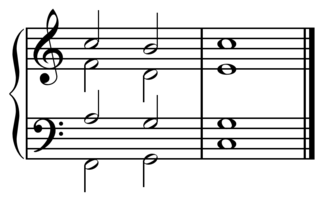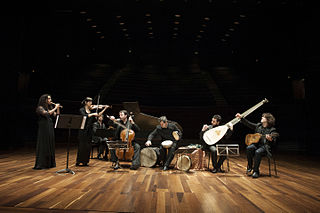
Claudio Giovanni Antonio Monteverdi was an Italian composer, string player, choirmaster, and priest. A composer of both secular and sacred music, and a pioneer in the development of opera, he is considered a crucial transitional figure between the Renaissance and Baroque periods of music history.

Giovanni Pierluigi da Palestrina was an Italian Renaissance composer of sacred music and the best-known 16th-century representative of the Roman School of musical composition. He had a long-lasting influence on the development of church and secular music in Europe, especially on the development of counterpoint, and his work is considered the culmination of Renaissance polyphony.

A lute is any plucked string instrument with a neck and a deep round back enclosing a hollow cavity, usually with a sound hole or opening in the body. It may be either fretted or unfretted.

Medieval music encompasses the sacred and secular music of Western Europe during the Middle Ages, from approximately the 6th to 15th centuries. It is the first and longest major era of Western classical music and followed by the Renaissance music; the two eras comprise what musicologists generally term as early music, preceding the common practice period. Following the traditional division of the Middle Ages, medieval music can be divided into Early (500–1150), High (1000–1300), and Late (1300–1400) medieval music.

Polyphony is a type of musical texture consisting of two or more simultaneous lines of independent melody, as opposed to a musical texture with just one voice, monophony, or a texture with one dominant melodic voice accompanied by chords, homophony.

Renaissance music is traditionally understood to cover European music of the 15th and 16th centuries, later than the Renaissance era as it is understood in other disciplines. Rather than starting from the early 14th-century ars nova, the Trecento music was treated by musicology as a coda to Medieval music and the new era dated from the rise of triadic harmony and the spread of the ' contenance angloise ' style from Britain to the Burgundian School. A convenient watershed for its end is the adoption of basso continuo at the beginning of the Baroque period.
In music, an accidental is a note of a pitch that is not a member of the scale or mode indicated by the most recently applied key signature. In musical notation, the sharp, flat, and natural symbols, among others, mark such notes—and those symbols are also called accidentals.

A clef is a musical symbol used to indicate which notes are represented by the lines and spaces on a musical stave. Placing a clef on a stave assigns a particular pitch to one of the five lines, which defines the pitches on the remaining lines and spaces.

An antiphon is a short chant in Christian ritual, sung as a refrain. The texts of antiphons are the Psalms. Their form was favored by St Ambrose and they feature prominently in Ambrosian chant, but they are used widely in Gregorian chant as well. They may be used during Mass, for the Introit, the Offertory or the Communion. They may also be used in the Liturgy of the Hours, typically for Lauds or Vespers.

Heinrich Isaac was a Netherlandish Renaissance composer of south Netherlandish origin. He wrote masses, motets, songs, and instrumental music. A significant contemporary of Josquin des Prez, Isaac influenced the development of music in Germany. Several variants exist of his name: Ysaac, Ysaak, Henricus, Arrigo d'Ugo, and Arrigo il Tedesco among them.

Tonality is the arrangement of pitches and/or chords of a musical work in a hierarchy of perceived relations, stabilities, attractions and directionality. In this hierarchy, the single pitch or triadic chord with the greatest stability is called the tonic. The root of the tonic chord forms the name given to the key; so in the key of C major, the note C is both the tonic of the scale and the root of the tonic chord. Simple folk music songs often start and end with the tonic note. The most common use of the term "is to designate the arrangement of musical phenomena around a referential tonic in European music from about 1600 to about 1910". Contemporary classical music from 1910 to the 2000s may practice or avoid any sort of tonality—but harmony in almost all Western popular music remains tonal. Harmony in jazz includes many but not all tonal characteristics of the European common practice period, sometimes known as "classical music".

A madrigal is a secular vocal music composition of the Renaissance and early Baroque (1600–1750) eras. The polyphonic madrigal is unaccompanied, and the number of voices varies from two to eight, but usually features three to six voices, whilst the metre of the madrigal varies between two or three tercets, followed by one or two couplets. Unlike the verse-repeating strophic forms sung to the same music, most madrigals are through-composed, featuring different music for each stanza of lyrics, whereby the composer expresses the emotions contained in each line and in single words of the poem being sung.

Historically informed performance is an approach to the performance of classical music, which aims to be faithful to the approach, manner and style of the musical era in which a work was originally conceived.

In Western musical notation, a dotted note is a note with a small dot written after it. In modern practice, the first dot increases the duration of the basic note by half of its original value. This means that a dotted note is equivalent to writing the basic note tied to a note of half the value – for instance, a dotted half note is equivalent to a half note tied to a quarter note. Subsequent dots add progressively halved value, as shown in the example to the right.

Ars antiqua, also called ars veterum or ars vetus, is a term used by modern scholars to refer to the Medieval music of Europe during the High Middle Ages, between approximately 1170 and 1310. This covers the period of the Notre-Dame school of polyphony, and the subsequent years which saw the early development of the motet, a highly varied choral musical composition. Usually the term ars antiqua is restricted to sacred (church) or polyphonic music, excluding the secular (non-religious) monophonic songs of the troubadours, and trouvères. However, sometimes the term ars antiqua is used more loosely to mean all European music of the thirteenth century, and from slightly before. The term ars antiqua is used in opposition to ars nova, which refers to the period of musical activity between approximately 1310 and 1375.
In music, a cantus firmus is a pre-existing melody forming the basis of a polyphonic composition.

A neume is the basic element of Western and Eastern systems of musical notation prior to the invention of five-line staff notation.

In music notation, a note value indicates the relative duration of a note, using the texture or shape of the notehead, the presence or absence of a stem, and the presence or absence of flags/beams/hooks/tails. Unmodified note values are fractional powers of two, for example one, one-half, one fourth, etc.

Mensural notation is the musical notation system used for European vocal polyphonic music from the later part of the 13th century until about 1600. The term "mensural" refers to the ability of this system to describe precisely measured rhythmic durations in terms of numerical proportions between note values. Its modern name is inspired by the terminology of medieval theorists, who used terms like musica mensurata or cantus mensurabilis to refer to the rhythmically defined polyphonic music of their age, as opposed to musica plana or musica choralis, i.e., Gregorian plainchant. Mensural notation was employed principally for compositions in the tradition of vocal polyphony, whereas plainchant retained its own, older system of neume notation throughout the period. Besides these, some purely instrumental music could be written in various forms of instrument-specific tablature notation.
In the years centering on 1600 in Europe, several distinct shifts emerged in ways of thinking about the purposes, writing and performance of music. Partly these changes were revolutionary, deliberately instigated by a group of intellectuals in Florence known as the Florentine Camerata, and partly they were evolutionary, in that precursors of the new Baroque style can be found far back in the Renaissance, and the changes merely built on extant forms and practices. The transitions emanated from the cultural centers of Northern Italy, then spread to Rome, France, Germany, and Spain, and lastly reached England . In terms of instrumental music, shifts in four discrete areas can be observed: idiomatic writing, texture, instrument use, and orchestration.

 listen (help·info))
listen (help·info))















